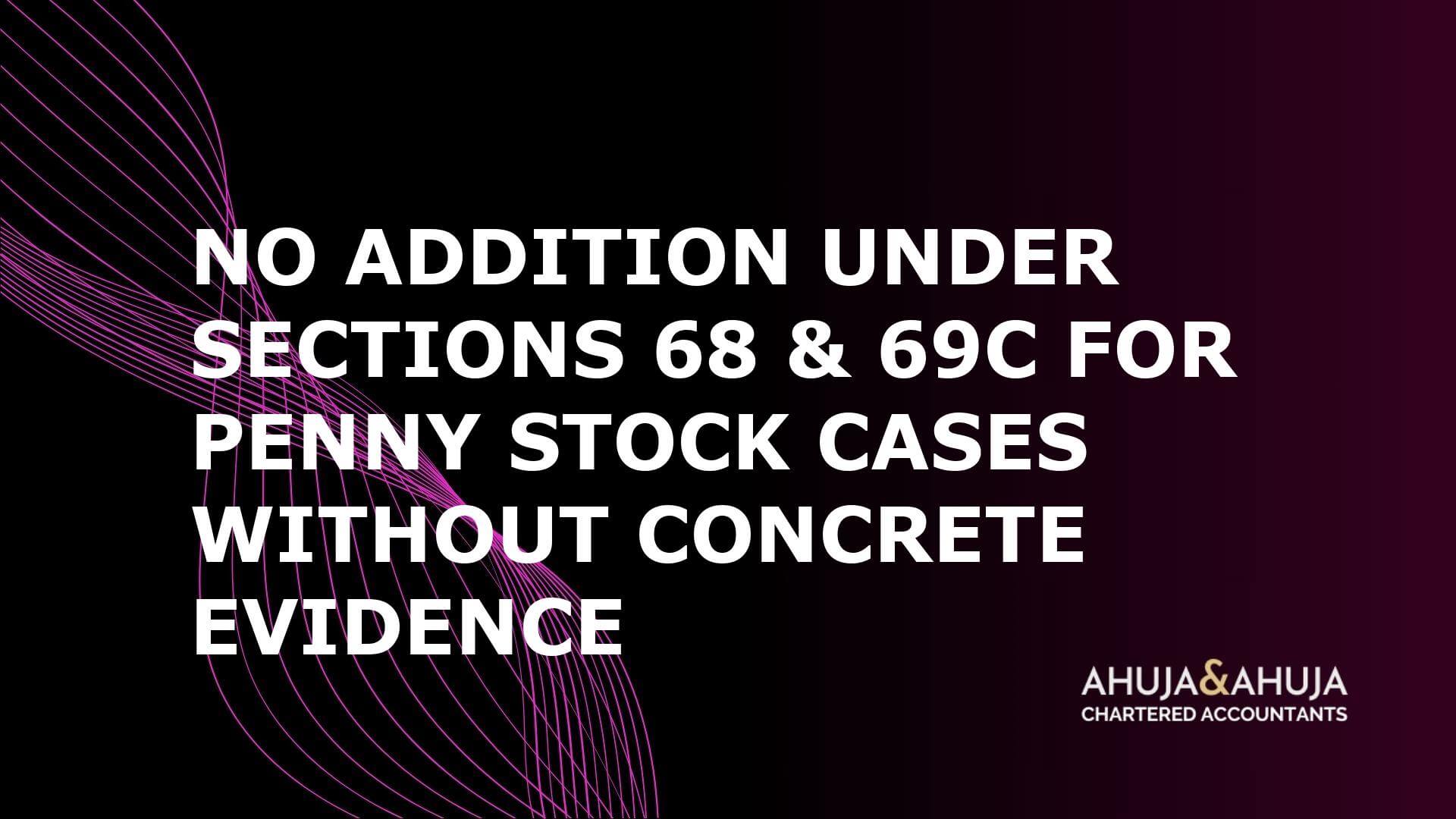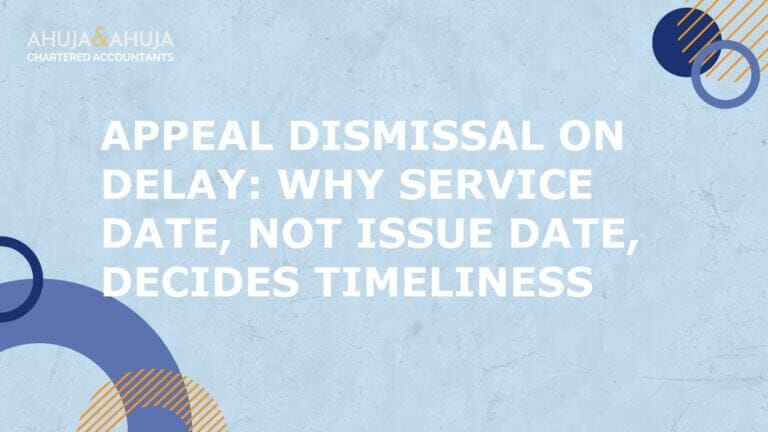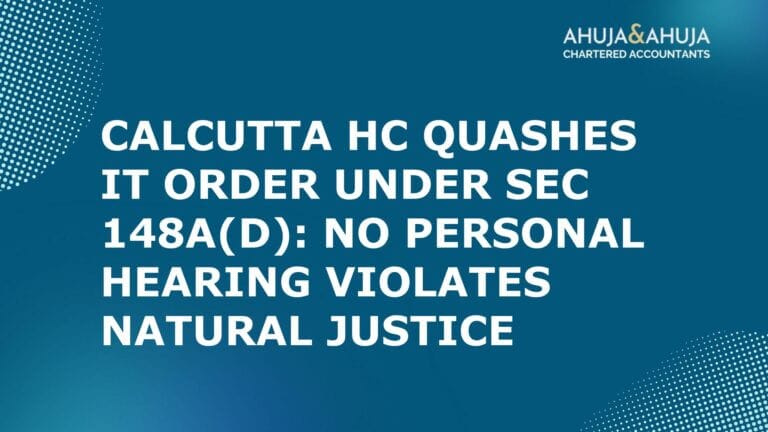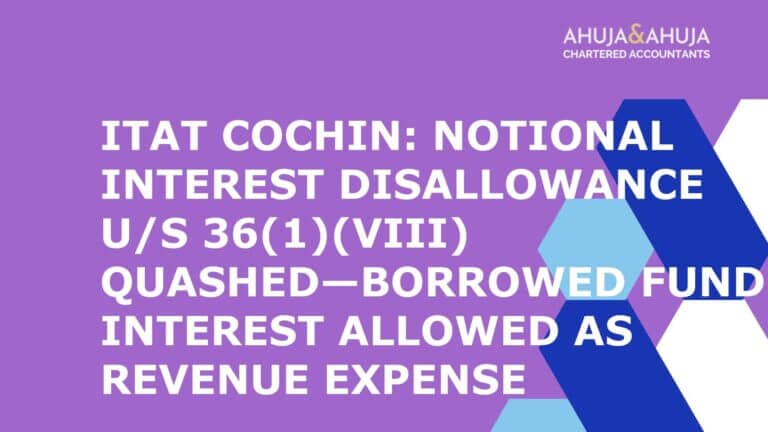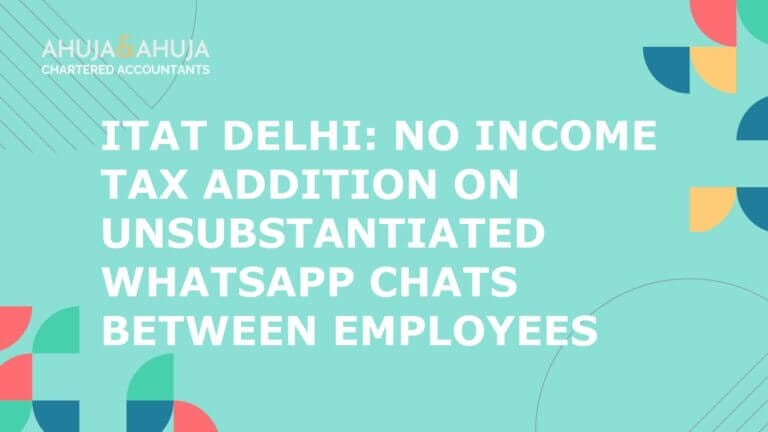No Addition Under Sections 68 & 69C for Penny Stock Cases Without Concrete Evidence
Penny stocks have long been a magnet for tax scrutiny in India. Their low price, high volatility, and occasional misuse for accommodation entries have made them a favourite target for the Income Tax Department. However, not every transaction in a flagged scrip is a sham. The real challenge for both taxpayers and professionals is separating genuine investment activity from manipulative schemes—especially when the taxman’s net is cast wide.
Recent years have seen a surge in assessments where additions under Section 68 (unexplained cash credits) and Section 69C (unexplained expenditure) are made simply because the taxpayer dealt in a “flagged” penny stock. Too often, these additions are based on broad investigation reports, price volatility, or the mere fact that a scrip is under the scanner—without any direct evidence linking the assessee to fund rotation, cash trails, or collusion.
This approach raises a fundamental question: Can mere involvement in a penny stock, without concrete evidence of manipulation or unaccounted income, justify additions under Sections 68 or 69C? The answer, as clarified by recent legal precedents, is a resounding no.
Objective and Relevance for CAs & Taxpayers
For Chartered Accountants and taxpayers, understanding the evolving legal landscape is crucial. The stakes are high: arbitrary additions can lead to hefty tax demands, prolonged litigation, and reputational risk. At the same time, the right documentation and defense can decisively tilt the scales in favour of the taxpayer.
This article unpacks the latest judicial thinking, especially from the Mumbai ITAT and Bombay High Court, and distils practical guidance for defending genuine transactions. Whether you’re advising clients, preparing for assessment, or facing an appeal, the insights here will help you navigate the maze with confidence. For professional assistance, firms like Chartered Accountants in Chandigarh offer expert support on complex tax matters.
Brief Overview of Recent Precedents
Two recent cases have set the tone for how penny stock transactions should be assessed:
- CIT v. Patel Road Associates (Bombay High Court, 2023): The High Court quashed additions under Section 68 where the taxpayer’s transactions were routed through SEBI-registered brokers, supported by contract notes, demat statements, and bank records. The Court held that presumption and suspicion, without specific adverse material, cannot justify additions.
- Shobha K. Shetty v. ITO (Mumbai ITAT, 2024): The Tribunal deleted additions in a Regency Trust Limited scrip case, noting that the AO relied only on general investigation findings and price volatility, without any direct evidence of manipulation or cash movement by the assessee. The ITAT emphasised that documentation and transaction routing through recognised channels are key.
These rulings reinforce a vital principle: the burden of proof lies with the Department, and additions cannot be made on mere suspicion or generic reports. Only concrete, case-specific evidence can justify invoking Sections 68 or 69C.
Key Takeaway for Practitioners
For CAs and taxpayers, the message is clear—robust documentation and transparent transactions are your best shield. At the same time, the Department must meet a high evidentiary threshold before making additions. The days of arbitrary assessments based on “guilt by association” with penny stocks are numbered, provided the facts and paperwork are in order.
Legal Framework: Sections 68 & 69C in Context
Understanding the legal backbone is essential before diving into the nuances of penny stock assessments. Sections 68 and 69C of the Income Tax Act are powerful tools in the Department’s arsenal, but their application is not without boundaries.
A. Section 68: Scope, Application, and Judicial Interpretation
Section 68 empowers the Assessing Officer (AO) to treat any sum credited in the books of an assessee as unexplained income if the assessee fails to satisfactorily explain its nature and source. Traditionally, this section is invoked for cash credits, share capital, or other receipts where the origin is in doubt.
However, courts have repeatedly clarified that the onus initially lies on the assessee to provide a plausible explanation, supported by documentation. Once the assessee produces credible evidence—such as contract notes, demat statements, and bank records—the burden shifts to the AO to rebut this evidence with concrete material. Mere suspicion, market rumours, or the “tainted” reputation of a scrip are not enough.
Key principle: Presumption cannot override proof. The AO must establish a clear link between the assessee and any alleged accommodation entry or manipulation.
For more on the burden of proof with respect to unexplained credits, see our detailed blog on Section 68, Gift: Onus on assessee to prove that donors had financial capacity to give gifts.
B. Section 69C: Scope, Application, and Judicial Interpretation
Section 69C deals with unexplained expenditure. If an assessee incurs any expenditure and cannot explain its source, the amount may be deemed as income. In penny stock cases, this is often invoked for alleged “commission” or “accommodation entry charges.”
Yet, as with Section 68, the law demands more than conjecture. The AO must demonstrate, with specific evidence, that the assessee actually incurred such expenditure and that it is unexplained. Blanket application based on industry trends or generic investigation reports does not meet the legal standard.
Judicial stance: The Department cannot simply estimate or assume expenditure without tracing a real outflow of funds or identifying a beneficiary.
C. Key Principles: Onus, Presumption versus Proof
- Initial Onus: The taxpayer must explain the transaction with supporting documents.
- Shift of Burden: Once documentation is provided, the AO must bring in direct, adverse material to challenge the genuineness.
- Presumption vs. Proof: Presumptions, however strong, cannot substitute for hard evidence. The courts have consistently held that suspicion, however grave, cannot take the place of proof.
Evidentiary Thresholds Established by Recent Rulings
The heart of the matter lies in what qualifies as “concrete evidence” for additions under Sections 68 and 69C, especially in the context of penny stocks.
A. What Constitutes ‘Concrete Evidence’?
- Direct Evidence:
- Fund Rotation: Tracing the actual movement of funds from the assessee to an entry provider and back.
- Cash Trails: Identifying cash deposits or withdrawals linked to the transaction.
- Collusion: Proof of the assessee’s involvement in price rigging or accommodation entry networks.
- Documentary Evidence:
- Bank Entries: Clear, traceable banking channels for purchase and sale consideration.
- Demat Credits: Shares credited and debited through recognised depositories.
- Contract Notes: Issued by SEBI-registered brokers, matching the transaction details.
- Correspondence: Emails or letters with brokers/exchanges confirming the trades.
Absence of these elements weakens the Department’s case.
B. Tribunal/High Court Guidance
Recent decisions have set a high bar for the Department:
- No Linkage, No Addition: If the AO cannot connect the assessee to any manipulation, fund layering, or cash movement, additions are unsustainable.
- Specific, Adverse Material Needed: General findings about a scrip or market trends are insufficient. The AO must present case-specific evidence against the assessee.
Example: In Shobha K. Shetty, the ITAT noted that the AO failed to examine the broker or the exchange, and did not bring any adverse material against the assessee. The entire addition was based on generic investigation reports and price volatility—both dismissed by the Tribunal.
C. Risks of Arbitrary Additions on Presumption
When additions are made solely on the basis of presumption or the “taint” of a scrip, they rarely survive appellate scrutiny. Such actions not only burden genuine taxpayers but also clog the appellate system with avoidable litigation.
Key takeaway: Concrete, case-specific evidence is the touchstone. Presumptions, however tempting, cannot replace proof.
For assistance in preparing documentation to meet evidentiary standards, firms offering Finance Services can be highly beneficial.
Practical Insight for CAs and Taxpayers
- Document every step: Maintain a clear paper trail—contract notes, demat statements, and bank records.
- Challenge vague allegations: If the AO relies on generic reports or fails to link you to any wrongdoing, highlight this in your response or appeal.
- Know your rights: The law is on your side if your transactions are genuine and well-documented.
Best Practices for Taxpayers & Advisors in Documenting Penny Stock Transactions
Navigating scrutiny in penny stock cases demands more than just honest intent—it requires airtight documentation and proactive compliance. For CAs and taxpayers, the right paperwork is not just a shield; it’s your strongest weapon against arbitrary additions under Sections 68 and 69C.
A. Standard Documentation Required
To pre-empt allegations of accommodation entries or bogus gains/losses, ensure the following records are maintained and readily accessible:
- Broker Contract Notes and SEBI Registration Proof
Always trade through SEBI-registered brokers. Retain original contract notes for every buy and sell transaction. If possible, keep a copy of the broker’s SEBI registration certificate or a printout from the SEBI website confirming their status. - Demat Statements
Maintain detailed demat account statements showing the credit and debit of shares. These statements should clearly reflect the movement of the specific scrip in question, matching the contract notes and bank entries. - Bank Statements (Cross-verification of Financial Flows)
Keep bank statements that show the flow of funds for both purchase and sale of shares. The payment for purchase should be traceable from your account to the broker, and sale proceeds should be credited directly from the exchange or broker. - Correspondence with Brokers/Exchanges
Save all email or written correspondence with your broker or the stock exchange regarding the transactions. This includes trade confirmations, clarifications, and any queries raised or resolved.
Tip: Where possible, obtain confirmations from the broker or the exchange regarding the genuineness of the transaction, especially if the scrip is later flagged.
B. Proactive Disclosure & Maintenance
- Timely Disclosure:
Disclose all share transactions in your income tax return, including details of purchase, sale, and resultant gains or losses. If a scrip is flagged or under investigation, consider making a voluntary disclosure in the computation or notes to accounts. - Organised Record-Keeping:
Maintain a digital and physical file for each scrip, with all supporting documents indexed and cross-referenced. This not only helps during assessment but also in appeals, where quick retrieval of evidence is crucial. - Periodic Review:
Regularly review your portfolio for flagged scrips and update your documentation accordingly. If you receive any notice or query from the Department, respond promptly and comprehensively.
C. Illustrative Checklist for Compliance
Here’s a quick-reference checklist for CAs and taxpayers dealing in penny stocks:
| Document/Action | Purpose | Best Practice |
|---|---|---|
| SEBI-registered broker contract notes | Proof of genuine, regulated transaction | Obtain for every trade |
| Demat account statements | Evidence of share movement | Match with contract notes and bank flows |
| Bank statements (purchase & sale) | Traceability of funds | Highlight relevant entries |
| Broker/Exchange correspondence | Confirmation of trade details | Save all emails and letters |
| Broker SEBI registration proof | Establishes broker’s legitimacy | Download from SEBI website if needed |
| Voluntary disclosure in ITR | Transparency with tax authorities | Add notes if scrip is flagged |
| Indexing and cross-referencing documents | Efficient retrieval during scrutiny | Use digital folders and physical files |
Pro tip: For every flagged scrip, prepare a summary sheet mapping each transaction to its supporting document. This makes it easier to respond to queries and demonstrate compliance.
Scrutiny of General or Circumstantial Evidence by Revenue Authorities
A recurring issue in penny stock assessments is the Department’s reliance on general or circumstantial evidence—such as investigation wing reports, price volatility, or the scrip’s reputation—without any direct link to the assessee’s conduct.
A. Typical Reliance: Investigation Wing Reports, Price Volatility
- Investigation Wing Reports:
These often list scrips or brokers allegedly involved in accommodation entries or price rigging. However, unless the report specifically names the assessee or traces a transaction to them, its evidentiary value is limited. - Price Volatility:
Sharp price movements or abnormal trading volumes in a scrip may raise suspicion, but they do not, by themselves, prove manipulation by a particular investor.
B. Judicial Response: Necessity of Case-Specific Connection
Courts and tribunals have repeatedly held that generic findings or market trends cannot justify additions unless the AO establishes a clear, case-specific connection. The Bombay High Court in Patel Road Associates and the ITAT in Shobha K. Shetty both emphasised that the Department must demonstrate how the assessee was involved in or benefited from any alleged manipulation.
Key principle: Suspicion, however strong, cannot replace proof. The AO must move from the general to the specific.
C. Limitation of Appellate Endorsement without Concrete Link
Appellate authorities are increasingly unwilling to endorse additions based solely on presumption or circumstantial evidence. Unless the AO can show:
- Direct involvement of the assessee in fund rotation or price rigging,
- Unexplained cash movement,
- Or collusion with entry operators,
the addition is likely to be struck down.
Practical Insight for CAs and Taxpayers
- Challenge the Evidence:
If the AO’s case rests only on general reports or price charts, demand specific material linking you to the alleged wrongdoing. - Highlight Transaction Trail:
Demonstrate that your trades were routed through regulated channels, with full documentation and no cash involvement. - Prepare for Appeal:
If arbitrary additions are made, be ready to contest them at the appellate stage, armed with your compliance file and the latest judicial precedents. For professional assistance, consulting a Chartered Accountant in Jodhpur can provide expert guidance in such complex disputes.
Disclaimer
The materials provided herein are solely for educational and informational purposes. No attorney/professional-client relationship is created when you access or use the site or the materials. The information presented on this site does not constitute legal or professional advice and should not be relied upon for such purposes or used as a substitute for professional or legal advice.

